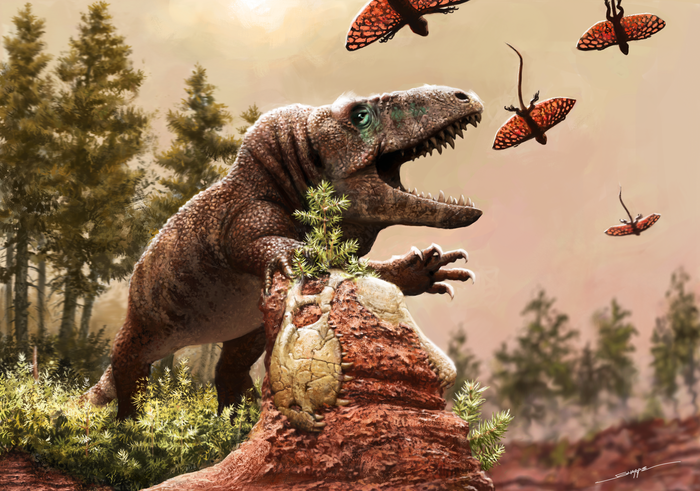Some 250 million years ago, during the conclusion of the Permian and the beginning of the Triassic, the rate of evolution and diversity amongst reptiles began to soar, resulting in a bewildering array of skills, body types, and characteristics.

Artistic reconstruction of the reptile adaptive radiation in a terrestrial ecosystem during the warmest period in Earth’s history. Image depicts a massive, big-headed, carnivorous erythrosuchid (close relative to crocodiles and dinosaurs) and a tiny gliding reptile at about 240 million years ago. The erythrosuchid is chasing the gliding reptile and it is propelling itself using a fossilized skull of the extinct Dimetrodon (early mammalian ancestor) in a hot and dry river valley. Image Credit: Henry Sharpe
This development helped to clearly define both their extinct lineages and those still living today as one of the most diverse groups of animals the world has ever seen.
For a long time, the reason for this success was thought to be the extinction of their rivals during two of the planet’s largest mass extinction events, which occurred around 261 and 252 million years ago.
By reconstructing how the anatomy of ancient reptiles developed and comparing it with millions of years of climatic change, a new study conducted by Harvard has rewritten that theory.
Researchers led by Harvard paleontologist Stephanie Pierce found that the morphological diversification and evolution of early reptiles began not just years before these mass extinction events, but also as a direct result of the climate change that led to those events in the first place.
We are suggesting that we have two major factors at play—not just this open ecological opportunity that has always been thought by several scientists—but also something that nobody had previously come up with, which is that climate change actually directly triggered the adaptive response of reptiles to help build this vast array of new body plans and the explosion of groups that we see in the Triassic.
Tiago R. Simões, Study Lead Author and Postdoctoral Fellow, Harvard University
“Basically, [rising global temperatures] triggered all these different morphological experiments—some that worked quite well and survived for millions of years up to this day, and some others that basically vanished a few million years later,” added Simões.
The researchers describe the extensive anatomical changes that occurred in many reptile groups, including the ancestors of crocodiles and dinosaurs, as a result of significant climate shifts that occurred between 260 and 230 million years ago in their paper, which was published on August 19th, 2022, in Science Advances.
The study offers a detailed examination of how a broad group of creatures evolved due to climate change, which is particularly important at this time given the steady increase in temperatures.
In fact, the amount of carbon dioxide released into the atmosphere today is around nine times greater than it was during the Permian-Triassic mass extinction, which occurred 252 million years ago and is considered to be the largest climate change-related mass extinction in history.
Major shifts in global temperature can have dramatic and varying impacts on biodiversity. Here we show that rising temperatures during the Permian-Triassic led to the extinction of many animals, including many of the ancestors of mammals, but also sparked the explosive evolution of others, especially the reptiles that went on to dominate the Triassic period.
Stephanie E. Pierce, Thomas D. Cabot Associate Professor, Organismic and Evolutionary Biology, Harvard University
Pierce is also a curator of vertebrate paleontology in the Museum of Comparative Zoology.
Simões traveled to more than 20 countries and more than 50 different institutions to take scans and photographs of more than 1,000 reptile fossils for the project, which required close to eight years of data collecting.
With all of the data, the researchers produced a sizable dataset that was examined using cutting-edge statistical techniques to generate a diagram known as an evolutionary time tree. Time trees show the relationships between early reptiles, the beginning of their lineages, and the rate of evolution. They then merged it with prehistoric global temperature records.
It is evident that these alterations were not brought about by the Permian-Triassic extinction as previously believed because reptile body plans began to diversify roughly 30 million years before the catastrophe. However, the extinction events did contribute to getting them going.
The data also revealed that most reptile lineages underwent fast bodily modifications after increases in global temperatures, which began around 270 million years ago and persisted until at least 240 million years ago.
For instance, some of the larger cold-blooded species have evolved to grow smaller to make room for an easier cooling down, while others have evolved to live in water to achieve the same result.
A large, long-necked aquatic reptile, originally believed to be the Loch Ness monster, a tiny chameleon-like creature with a bird-like skull and beak, and a gliding reptile like a gecko with wings were all part of the latter group. Furthermore, it includes the ancestors of modern reptiles like turtles and crocodiles.
The ancestors of the first lizards and tuataras were smaller reptiles who followed a distinct evolutionary trajectory from that of their larger reptile cousins. The increasing temperatures caused their evolutionary rates to slow and stabilize.
According to the researchers, the reason is that smaller-bodied reptiles were already more acclimated to the increasing heat because they could dissipate heat from their bodies more readily than larger reptiles when temperatures rose rapidly all across Earth.
The researchers intend to build on this study by examining the effects of environmental disasters on the evolution of species with a great deal of modern diversity, such as the major lizard and snake groups.
Journal Reference:
Simões, T. R., et al. (2022) Successive climate crises in the deep past drove the early evolution and radiation of reptiles. Science Advances. doi:10.1126/sciadv.abq1898.